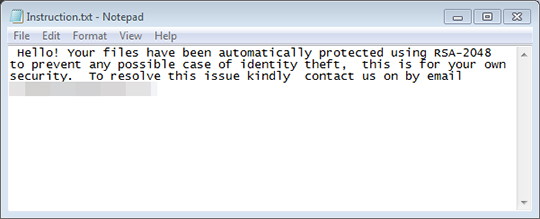RANSOM_PASTMONTH.A
Ransom.CryptXXX(Norton);
Windows


Threat Type: Ransomware
Destructiveness: No
Encrypted: No
In the wild: Yes
OVERVIEW
Dropped by other malware, Downloaded from the Internet
This Ransomware arrives on a system as a file dropped by other malware or as a file downloaded unknowingly by users when visiting malicious sites.
It deletes itself after execution.
It drops files as ransom note.
TECHNICAL DETAILS
28,672 bytes
EXE
No
01 Aug 2017
Steals information, Displays message/message boxes, Encrypts files
Arrival Details
This Ransomware arrives on a system as a file dropped by other malware or as a file downloaded unknowingly by users when visiting malicious sites.
Other Details
This Ransomware connects to the following URL(s) to get the affected system's IP address:
- https://whoer.net
It does the following:
- Sends the following info to the e-mail rsa2048pro@{BLOCKED}n.is:
- machine name
- encryption elapsed time
- encrypted files count
- Size
- error files
It deletes itself after execution.
Ransomware Routine
This Ransomware avoids encrypting files with the following strings in their file name:
- .aes
- .sys
- .SYS
- .ani
- .cpl
- .cur
- .dat
- .deskthemepack
- .diagcab
- .diagpkg
- .dmp
- .drv
- .hlp
- .icl
- .icons
- .ico
- .mod
- .msp
- .msstyles
- .ocx
- .rtp
- .themepack
- .CAB
- .settingcontent-ms
- .lnk
It avoids encrypting files found in the following folders:
- Program Files
- Windows
- ProgramData
- C:\Users\All Users\Microsoft
- C:\Users\Default\AppData\Roaming\Microsoft
- AppData\Local\Packages
- AppData
- WINDOWS
- bootmgr
- BOOTNXT
- Desktop
- \Desctop
It appends the following extension to the file name of the encrypted files:
- .aes
It drops the following file(s) as ransom note:
- {Encrypted file directory}\Instruction.txt
It leaves text files that serve as ransom notes containing the following text:
SOLUTION
9.850
13.568.08
01 Aug 2017
13.569.00
02 Aug 2017
Step 1
Before doing any scans, Windows XP, Windows Vista, and Windows 7 users must disable System Restore to allow full scanning of their computers.
Step 2
Note that not all files, folders, and registry keys and entries are installed on your computer during this malware's/spyware's/grayware's execution. This may be due to incomplete installation or other operating system conditions. If you do not find the same files/folders/registry information, please proceed to the next step.
Step 3
Search and delete these files
- {Encrypted file directory}\Instruction.txt
Step 4
Scan your computer with your Trend Micro product to delete files detected as RANSOM_PASTMONTH.A. If the detected files have already been cleaned, deleted, or quarantined by your Trend Micro product, no further step is required. You may opt to simply delete the quarantined files. Please check this Knowledge Base page for more information.
Step 5
Restore encrypted files from backup.
Did this description help? Tell us how we did.



